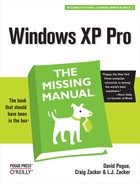- Windows XP Pro Edition: The Missing Manual, 2nd Edition
- What the Reviewers Said
- The Missing Credits
- Introduction
- I. The Windows XP Desktop
- 1. The Desktop and Start Menu
- Logging In
- The Elements of the XP Desktop
- The Start Menu
- Start→Log Off
- Start→Shut Down (Turn Off Computer)
- Start→All Programs
- Start→Run
- Start→Search
- Start→Help and Support
- Start→Control Panel
- Start→Set Program Access and Defaults
- Start→My Network Places
- Start→My Computer
- Start→My Music, My Pictures
- Start→My Recent Documents
- Start→My Documents
- Customizing the Start Menu
- 2. Windows, Folders, and the Taskbar
- 3. Organizing Your Stuff
- 4. Getting Help
- 1. The Desktop and Start Menu
- II. The Components of Windows XP
- 5. Programs and Documents
- 6. The Freebie Software
- The Windows XP Accessories
- Windows XP Games
- Everything Else
- 7. Pictures, Sound, and Movies
- 8. The Control Panel
- Category View: The Big XP Change
- Accessibility Options
- Add Hardware
- Add or Remove Programs
- Administrative Tools
- Automatic Updates
- Bluetooth Devices
- Date and Time
- Display
- Folder Options
- Fonts
- Game Controllers
- Internet Options
- Keyboard
- Mouse
- Network Connections
- Network Setup Wizard
- Phone and Modem Options
- Power Options
- Printers and Faxes
- Regional and Language Options
- Scanners and Cameras
- Scheduled Tasks
- Security Center
- Sounds and Audio Devices
- Speech
- System
- Taskbar and Start Menu
- User Accounts
- Windows Firewall
- Wireless Network Setup Wizard
- III. Windows Online
- 9. Hooking Up to the Internet
- 10. Security, Firewalls, and Service Pack 2
- 11. Web, Chat, and Videoconferencing
- Internet Explorer
- Windows Messenger
- 12. Outlook Express 6
- IV. Plugging into Windows XP
- 13. Printing, Fonts, and Faxing
- 14. Hardware
- 15. Joining, Compressing, and Encrypting Disks
- 16. Maintenance, Backups, and Troubleshooting
- V. Life on the Network
- 17. Accounts, Permissions, and Logging On
- Introducing User Accounts
- Windows XP: The OS With Two Faces
- Local Accounts on a Workstation
- Local Accounts on a Domain Computer
- Local Users and Groups
- Setting Up the Logon Process
- Logging On
- Profiles
- NTFS Permissions: Protecting Your Stuff
- 18. Setting Up a Workgroup Network
- 19. Introducing Network Domains
- 20. Sharing Network Files
- 21. Three Ways to Dial In from the Road
- 17. Accounts, Permissions, and Logging On
- VI. Appendixes
- A. Installing Windows XP Pro
- B. Windows XP, Menu by Menu
- C. Fun with the Registry
- Index
- Colophon
Some extremely sophisticated programming has gone into the typefaces that are listed in the Fonts dialog boxes of your word processor and other programs. They use OpenType and TrueType technology, meaning that no matter what point size you select for these fonts, they look smooth and professional—both on the screen and when you print.
Windows XP comes with several dozen great-looking OpenType and TrueType fonts: Arial, Book Antiqua, Times New Roman, and so on. But the world is filled with additional fonts. You may find them on the CD-ROMs that come with PC magazines, on Windows software Web sites, or in the catalogs of commercial typeface companies. Sometimes you’ll find new fonts on your system after installing a new program, courtesy of its installer.
To review the files that represent your typefaces, open the Fonts icon in the Control Panel.
Figure 13-11. All of your fonts sit in the Fonts folder (top); you’ll frequently find an independent font file for each style of a font: bold, italic, bold italic, and so on. You can tell a TrueType font by its TT icon, or an OpenType font by its O icon. Those marked by an A may be PostScript fonts, which come with a phalanx of the printer font files that they require; others may look fine on the screen, but may not print out smoothly. Double-click a font’s icon to see what the font looks like (bottom).
Tip
The Fonts icon in your Control Panel window is only a shortcut to the real folder, which is in your Local Disk (C:)→Windows→Fonts folder.
When you open the Fonts folder, you’ll see that for every font that appears in the Font menus of your various programs, there’s an icon on your hard drive—or several. As Figure 13-11 illustrates, it’s easy and enlightening to explore this folder.
To remove a font from your system, simply drag its file icon out of this window, right-click it and then choose Delete from the shortcut menu, or highlight it and then choose File→Delete. To install a new font, drag its file icon into this window (or choose File→Install New Font, and then navigate to, and select, the font files you want to install).
Either way, you’ll see the changes immediately reflected in your programs’ Font dialog boxes.
Tip
Some fonts appear in your menus, but not in your Fonts menu. These are the fonts that Windows uses in its menus, windows, and dialog boxes (Courier, MS Sans Serif, Small Fonts, Symbol, and so on). If you accidentally remove or move any of these fonts, Windows will substitute something that doesn’t look right, and you’ll wonder what the heck is going on with the typography of your programs. That’s why, unless you’ve turned on the “Show hidden files” option (Figure 2.8), these files are invisible in the Fonts folder.
-
No Comment

